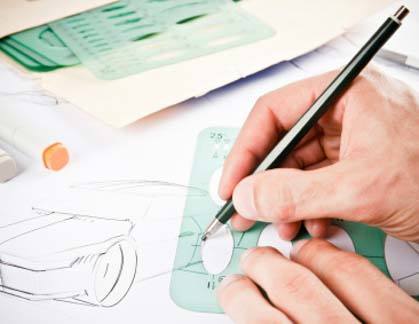Industrial Design vs. Graphic Design
How is industrial design different from graphic design?
The aesthetics of life in the modern world are shaped by a range of design professionals—graphic designers, web designers, fashion designers, interior designers.
But there are unsung heroes of the design field who are responsible for the appearance and quality of just about every manufactured product, from cars to furniture to toys.
Industrial design may not have a glamorous-sounding name, but it permeates our everyday life in countless ways.
How Do the Design Fields Differ?
Graphic design is the most visible area of the design field, thanks to graphics-heavy websites, advertisements and print media. Graphic designers are indispensable to creating effective and attractive visual communication in just about every industry.
Industrial design is just as widespread, but it calls on a slightly different set of skills than those required in graphic design. If you're interested in an industrial design career, here's a quick overview of what industrial designers do and what they need to know:
- Like designers in other fields, professionals in industrial design need to have a lot of creativity. They may be called upon to tackle a range of design problems, solving them in a way that not only maximizes the aesthetic result but also addresses practical issues such as materials, usability and safety.
- The various subsets of industrial design, such as appliance design or furniture design, call for distinctly different areas of technical expertise. Industrial designers need to consider the effective use of computer-aided design software, materials and technology, manufacturing methods, and other concerns relevant to producing items that are both visually appealing and useful to consumers. Engineering knowledge is often a plus.
- Industrial designers need outstanding communication and teamwork skills. You will need to work with a wide range of other employees in different departments, from engineering and accounting to marketing and management, in order to design a product that meets the needs of the client while also remaining cost-effective, safe and easy to use.
- The U.S. Bureau of Labor Statistics reports that the majority of entry-level jobs in industrial design require at least a bachelor's degree in industrial design, architecture or engineering. Besides helping you learn the relevant design, manufacturing, ergonomics and engineering principles, a college education will help you build your portfolio and find internships to enhance your work experience.
- Industrial designers need basic business knowledge. Working with clients, staying within budget, observing necessary regulations, strategic business planning—these factors are increasingly important to industrial designers because of their critical role on the production team.
Categories
Graphic Design Degree & Career Guide
- 4 Creative Ways to Use Your Graphic Design Degree
- 5 Graphic Design Portfolio Tips
- Advertising Degrees and You
- Advertising Design Job Description
- Advertising Designer Profile
- Careers in Computer-Aided Design
- Choosing Industrial Design Programs
- Education Initiatives Designed to Boost Enrollment in CAD Drafting School
- Graphic Design and Technology
- Graphic Design School and Career Guide
- Graphic Designer Job Outlook
- Graphic Designer Profile
- How to Get Ready for Graphic Design School
- Illustrator Career Paths: Job Duties, Education and More
- Industrial Design vs. Graphic Design
- Industrial Designer Job Description
- Industrial Designer Profile
- On-the-Job Graphic Design Training

